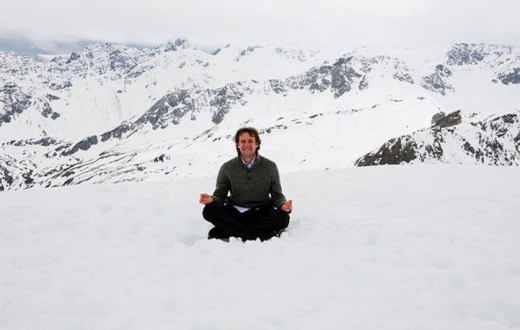
It’s no secret that work can be stressful. Whether it’s dealing with tight deadlines, resolving conflict in the workplace, or just feeling like you never have a moment to breathe, the workday can quickly become overwhelming.
Over time, the stress of our daily responsibilities can lead to burnout, especially if we don’t develop the right techniques to destress or strike a work-life balance. That’s why many companies are starting to recommend meditation to their employees, which can help them combat workplace stress.
One of the great things about meditation is that it can be done anywhere, including your desk or wherever else you may work. It doesn’t require any special equipment, making it accessible to nearly everyone. Best of all, it does more than just help you destress — with regular practice you’ll also improve your focus, be more productive, and find a sense of peace.
Want to learn more about meditation at work? If so, you’re in the right place! We’ll cover everything you need to know to get started and improve your work habits through meditation.
Topics Covered:
- Reap the benefits of meditation at work
- Practice these three types of meditation at work
- Top tips for meditating at work
- Decrease your work stress with The Art of Living
Reap the benefits of meditation at work

Regular meditation practice is beneficial in so many ways, but it’s especially useful in the workplace. Since we tend to be stressed or overwhelmed at work, using meditation as a way to reduce negative feelings and increase positive ones is impactful. Those who practice it regularly notice the following benefits.
Improved focus
One of the great things about meditation is that it leads to mindfulness, which involves being present at the moment. When you’re focused on the present, you’re less distracted, and this can boost your quality of work. You’ll be a better listener and communicator, able to give your full attention to your clients or coworkers.
These improvements help you avoid silly mistakes or careless misunderstandings that result when you multitask or aren’t fully paying attention because your mind wanders. And, these same skills make you better at problem-solving.
Decreased stress
Meditation calms our nervous system, reducing cortisol and lowering the heart rate and blood pressure. However, it does much more, even resulting in changes to the brain over time that help us better regulate our emotions. This is the result of changes to the medial prefrontal cortex, which is responsible for fear, stress, and anxiety.
Meditation decreases the neurological connections in this area, reducing the negative feelings we experience daily. Meanwhile, meditation increases gray matter and cortical thickness, allowing us to regulate our emotions, learn, and solve problems with more ease. Even if we face uncomfortable or unpleasant thoughts, we’re able to respond to them with calm, resulting in less stress.
Improved productivity
When you’re stressed out, it’s hard to be productive, whether due to a racing mind or drained energy. The stress relief meditation provides can help you have a clearer mind and stop worrying about yesterday or tomorrow. Rather, you can think about what you need to do in the present moment, allowing you to get more done and make better decisions.
Reduced risk of burnout
Meditation helps you increase your self-awareness. As a result, you’re more in tune with your needs, and this leads to positive impacts. You know when you need a break or how to take care of yourself at the moment. This leads to overall improved levels of satisfaction at work, an improved mood, and better performance. All of this helps combat burnout.
Improved collaboration
When one or more teammates practice meditation, collaboration is easier. One reason is that when team members are less stressed, they are less reactive, which results in less conflict. However, meditation also helps foster feelings of compassion and improves focus, leading to better communication.
Practice these 3 types of meditation at work

There are a multitude of meditation programs out there, ranging from mindfulness practices to guided meditation apps. If you’ve never tried meditation practice before, you may not know how to start. We’ve got you covered! The following techniques are great for practicing a few minutes of meditation at work.
SKY Breath Meditation
If you find it hard to make time for meditation and want to follow a technique that incorporates breathing exercises, SKY Breath Meditation is a great choice. It’s perfect for beginners, but that doesn’t mean it’s less effective than other meditation training programs. With each deep breath, you’ll experience improved focus, decreased stress, and a number of other incredible benefits.
Mantra meditation
This mantra-based meditation allows the mind to settle and experience deep relaxation. It helps us remove ourselves from stress and anxiety so we can feel calm and alert during our busy schedules. Our Sahaj Samadhi workshop can help you learn more about mantra meditations and start practicing them on your own!
Compassion meditation
If you want to be more compassionate, this type of meditation can help guide you in the right direction. It helps us to tap into and embrace our innate sense of compassion. Compassion meditations give us a sense of inner peace and help us in our dealings with others, even those who may be difficult. The Art of Living Journey App is a great place to start if you want to try guided compassion meditation.
Top tips for meditating at work

Now that we’ve covered the health benefits of meditation and some of the meditation techniques you can use, it’s time to put them to work. Wondering how to get started? These tips can help!
Find a secluded, quiet area: It may be difficult to meditate if your work environment is crowded or overstimulating. Whether it’s a conference room, your office, or even your car, look for a quiet environment where you can meditate without disruptions.
Make your practice part of your daily schedule: When you do something at the same time every day, it becomes a habit. So if you want to stick to your meditation practice long-term, put it on your schedule. Block out 10 to 15 minutes at a time you usually aren’t interrupted for best results. The earlier in the day, the better, just in case something unexpected happens.
Invite coworkers to join: Meditating with coworkers can foster a healthy work environment and improve relationships between team members. It creates a sense of unity, builds compassion, and may even help resolve conflict. So, why not invite others to join you for a group stress-reduction session?
Take your practice outdoors: If you can’t find a quiet spot in your office or you just want to get away from your work environment for a few minutes, head outside! If there’s a park, a bench, or just a patch of grass nearby, you can make it your usual meditation spot.
Mute notifications: Finding a quiet spot may not be enough if you bring along your phone or smartwatch. Constant notifications from social media, emails, and phone calls make it difficult to stay focused on your meditation session. Turn off notifications or leave your devices at your desk so you can get the most out of your practice.
Decrease your work stress with The Art of Living

There are so many reasons to incorporate meditation into your work routine, especially when you consider how it positively impacts your mental health and performance. Of course, finding the time to meditate at work may be a challenge, but with the help of these tips, you can make a success of it!
If you’d like to get started with meditation, we invite you to browse our courses and resources at The Art of Living! We offer all the meditation courses mentioned above, including SKY Breath Meditation, mantra meditations, and guided meditations.






























